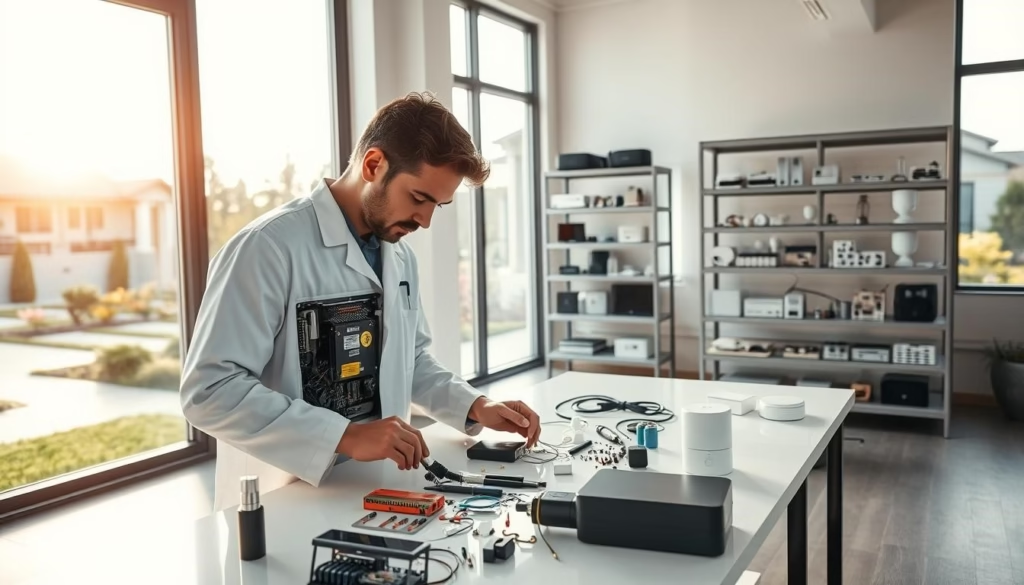Table of Contents
Imagine coming home to a house that adjusts to your every need. It changes the temperature and lighting to make your life easier. This is the future of smart home automation, where technology makes your life better.
With a smart home system, you get more efficiency, sustainability, and personal experiences. Home automation is changing how we live, work, and interact. Automated smart devices lead this revolution.

Looking ahead, smart home automation will shape our lives. AI-driven homes, predictive automation, and voice recognition systems offer endless possibilities. More connected devices will make smart home systems seamless.
Energy-efficient smart devices will cut down power use, reducing our carbon footprint. Whether upgrading or building a new home, a smart system makes it more comfortable, convenient, and green.
Key Takeaways
- Smart home automation systems can increase convenience, efficiency, and sustainability in your home.
- Home automation technology is transforming the way we live, work, and interact with our surroundings.
- Automated smart home devices can help reduce energy consumption and our carbon footprint.
- The future of smart home automation lies in seamless integration, AI-driven personalization, and enhanced connectivity.
- Smart home automation can help you create a more comfortable, convenient, and sustainable living space.
- Energy-efficient smart devices can optimize power usage, reducing energy consumption by 20-30% during peak hours.
- Smart security systems can utilize facial recognition technology, reducing false alarms by up to 90%.
Understanding Smart Home Automation System Basics
Smart home integration is key in today’s homes, thanks to wireless home automation and iot home automation. The number of IoT devices has skyrocketed. In 2015, there were about 15 billion devices. By 2020, this number jumped to 200 billion.
Smart home systems have control hubs, smart sensors, and actuators. These parts work together for a smooth smart home experience. They let users control things like lights, heat, and appliances. IoT home automation makes our homes connected and easy to use.
Smart home tech offers many benefits. It makes life easier, saves energy, and boosts security. For example, smart thermostats like Nest can cut heating and cooling costs by 12%. Smart lights adjust automatically, making our homes more comfortable.
Smart home tech includes AI for personalization and better energy use. It’s also important for devices from different makers to work well together. As the smart home market grows, smart home integration and wireless home automation become more vital for a connected home.
Getting Started with Home Automation Technology
Home automation services are getting more popular. They let homeowners control lights, heat, and appliances easily. This makes daily life more convenient and efficient. Plus, smart homes use less energy, which can lower bills.
Starting with home automation has many options. Homeowners can buy smart devices like thermostats and cameras. They can connect these to their home systems. Voice assistants like Amazon Alexa or Google Assistant help control the home with voice commands.
Some key benefits of home automation include:
- Increased convenience and efficiency
- Reduced energy bills and carbon footprint
- Enhanced home security through automated lighting and alarm systems
- Improved comfort and control through motorized systems, such as blinds and curtains
Investing in home automation services makes homes more comfortable and efficient. Homeowners can control and monitor their homes from anywhere. This brings peace of mind and many benefits of home automation.
Essential Components of a Smart Home Automation System
A smart home system has many parts that work together. At its core are automated smart home devices. These can be controlled and watched from anywhere using smart home integration. This makes it easy to change settings, check energy use, and get alerts.
The smart home market is growing fast, expected to hit $174 billion by 2025. About 69% of homeowners want smart home tech. With more devices at home, smart integration is key for a better living experience.
Control Hubs and Central Management
Control hubs and central management systems are vital. They help devices talk to each other, even if they use different ways like Zigbee or Wi-Fi. These hubs are the smart home’s brain, letting homeowners control everything from one place. This brings more convenience, saves energy, and boosts security.
Smart Sensors and Actuators
Smart sensors and actuators are key to a smart home. They give real-time info and let things happen automatically. For example, motion sensors can alert you to unexpected visitors. Smart thermostats can adjust to your habits, making your home comfy and efficient.
Network Infrastructure Requirements
A strong network is needed for smart homes. It lets devices talk to each other smoothly. With more devices at home, a solid network is vital for a good smart home experience.
Implementing IoT Integration in Your Home
IoT integration is key in smart home automation. It lets devices talk to each other smoothly, making a single system. With billions of IoT devices expected soon, knowing IoT’s benefits is vital. It brings more convenience, efficiency, and saves money.
Choosing the right devices is important for IoT integration. Pick ones that use the same tech, like Wi-Fi or Zigbee. A central hub or gateway is needed to connect all devices.
Fixing common problems is also key for a smooth system. Look for risks and act early to avoid them. With IoT integration, you get a unified system, more convenience, and save money.
Benefits of IoT Integration | Description |
Increased Convenience | IoT integration lets devices talk smoothly, making home control easier. |
Efficiency | IoT makes homes more efficient by saving energy and reducing waste. |
Cost Savings | IoT helps save money by cutting energy use and making devices last longer. |
Voice and Gesture Control Solutions
Voice-controlled home automation is getting more popular. It lets homeowners control their devices without using their hands. This is thanks to voice assistants and gesture recognition technology.
The DFRobot Gravity GR10-30 Gesture Sensor can recognize 12 different gestures. The DFRobot Gravity Offline Language Learning Voice Recognition Sensor supports 121 pre-programmed commands.
Using voice-controlled home automation makes life easier. Homeowners can manage their homes with simple voice commands. The gesture sensor’s adjustable recognition distance is up to 30 cm for precise control.
The voice recognition module lets users set 17 custom command words and wake words. This makes the experience more personal.
- Swipe right to change the relay position from 1 to 4
- Swipe left to change the relay position from 4 to 1
- Swipe up/down to turn the selected relay ON or OFF
These features make controlling devices easy. Voice-controlled home automation is becoming a favorite choice for many. As technology improves, we’ll see even more smart solutions for our homes.
Maximizing Energy Efficiency Through Automation
Smart home automation can make your home more energy-efficient. It helps cut down on energy use and costs. Homeowners can save up to 30% on their energy bills with these systems.
Smart thermostats, automated lighting, and energy monitoring are key. They help you use energy wisely. This leads to lower bills and more comfort.
For instance, smart thermostats can save 10-12% on heating and 15% on cooling each year. Smart lights can cut energy waste by up to 40% by adjusting to natural light.
Smart plugs and outlets can also spot energy waste, saving 5-10% more. Getting a smart home system boosts your home’s value by 5-10% too.

Smart home tech brings big energy savings and comfort. The global smart home market is set to hit $174 billion by 2025. It’s clear that smart homes are the future of energy efficiency.
Enhanced Security Features for Smart Homes
Smart home solutions bring many security features to the table. They give homeowners more peace of mind. With the growth of home automation, it’s key to think about security. Kaspersky found that 56% of users worry about their smart home devices being hacked or spied on.
Smart homes offer real-time monitoring, motion detection, and remote access. These are great for those who are away for a long time. They can also work with other security systems like alarms and cameras for a full security package.
To keep smart homes safe, it’s important to use strong passwords and two-factor authentication. Keeping software up to date is also vital to avoid security issues. By doing these things, homeowners can enjoy smart home benefits while staying safe.
- Increased peace of mind for homeowners
- Improved safety and security
- Remote monitoring and control
- Integration with other security systems
Investing in smart home solutions and home automation makes living safer and more convenient. With the right security and practices, smart homes are a safe and cozy place to live.
Artificial Intelligence in Home Automation
Artificial intelligence is changing how we live in our homes. It makes it easy to connect automated smart home devices together. Homeowners get more convenience, efficiency, and personal touches. AI helps devices work together smoothly.
AI brings many benefits to home automation. It includes predictive automation, machine learning, and personal assistants. For example, AI systems can adjust your home’s settings based on your habits. This makes your home more comfortable and saves energy.
AI can control up to 80% of your home’s functions, like lights and temperature. Smart homes with AI can save up to 30% on energy. The AI home automation market is growing fast, expected to hit $174 billion by 2030.
To enjoy AI’s benefits, homeowners should connect automated smart home devices with their systems. This includes voice assistants, smart thermostats, and lights. It makes living easier, more efficient, and eco-friendly.
Wireless Home Automation Technologies
Wireless home automation is getting more popular. It lets people control their devices easily. With iot home automation, daily life gets more convenient and efficient. Options like Wi-Fi, Bluetooth, and Zigbee offer benefits like remote control, saving energy, and better security.
Some key benefits include:
- Increased convenience and efficiency
- Remote access and control of devices
- Energy efficiency and cost savings
- Enhanced security and safety features
For instance, wireless home automation can work with smart thermostats. This can save homeowners 10-12% on heating and 15% on cooling bills. Also, wireless sensors can send alerts for unusual activities. This adds to the security and peace of mind.
As more people use wireless home automation, it will get even better. The mix of iot home automation and AI will make smart homes smarter. With 5G, communication between devices will get faster and more reliable. This will make using smart home devices smoother.
Maintaining and Upgrading Your Smart Home System
Keeping your smart home system in top shape is key. This means updating software and replacing devices. It helps avoid problems and keeps your system running smoothly and safely. With smart home solutions and home automation services, you get more comfort, convenience, and save on energy.
A well-kept smart home can cut energy use by up to 30%, studies show. Homes with smart tech use 25% less energy than those without. To keep your system running well, here are some tips:
- Update your system’s software regularly for the latest features and security
- Replace devices as needed to avoid technical issues and ensure they work together
- Keep an eye on how your system is doing to find ways to make it better
By following these tips and using home automation services, you’ll enjoy many benefits. Your smart home will be more efficient, secure, and convenient. As more people want smart home solutions, staying current with new tech is important.

By focusing on maintenance and upgrades, your smart home will keep meeting your needs. It will stay comfortable, convenient, and energy-saving. With the right smart home solutions and home automation services, your home will be smarter and more efficient for years.
Conclusion: Embracing the Smart Home Revolution
The future of smart home automation is very exciting. It brings seamless integration, AI-driven personalization, and better energy efficiency. As the global smart home market grows, more homeowners are enjoying the benefits of these advanced technologies.
Smart thermostats and lighting systems can cut energy use by up to 15%. AI-powered predictive maintenance also helps appliances last longer. The ENERGY STAR SHEMS program shows how smart homes can make energy management easier and help the planet.
Voice control, gesture recognition, and AI assistants make smart homes even better. They help homeowners manage their daily tasks more easily. With prices dropping, more people can join the smart home revolution, changing how we live and interact with our homes.
By exploring home automation technology, homeowners can enjoy more convenience, save energy, and get personalized services. The smart home revolution is underway, and it’s time for everyone to be a part of it.
FAQ's
What defines modern home automation?
Modern home automation uses AI, IoT devices, and renewable energy. It makes homes more intuitive and responsive. This improves convenience, efficiency, and sustainability.
What are the core components of a smart home system?
A smart home system has control hubs, smart sensors, and actuators. It also needs a strong network. This network lets devices and systems talk to each other smoothly.
What are the benefits of home automation technology?
Home automation brings more convenience, energy savings, and security. It also lets you use AI for a more personalized smart home.
How do I get started with home automation technology?
Start by looking at smart devices like thermostats and cameras. Then, connect them with your home systems for a seamless experience.
How do I ensure successful IoT integration in my home?
Choose devices that work well together. Set up communication protocols and solve any issues. This ensures a smooth smart home experience.
What are the benefits of voice and gesture control solutions in smart homes?
Voice and gesture control make homes more convenient. They let you control devices easily without touching them.
How can smart home automation help maximize energy efficiency?
Smart home automation uses smart thermostats and lights. It also monitors energy use. This reduces costs and saves energy.
What enhanced security features are available for smart homes?
Smart homes have better security with biometric authentication and real-time monitoring. This gives homeowners more peace of mind.
How can artificial intelligence be integrated into smart home automation?
AI is integrated through machine learning and predictive features. It also works with personal assistants. This boosts convenience and efficiency.
What wireless home automation technologies are available?
There are Wi-Fi, Bluetooth, and Zigbee options. Mesh networks are also available. They all make homes more convenient and efficient.
How do I maintain and upgrade my smart home system?
Keep your system updated by updating software and replacing old devices. This ensures your smart home runs smoothly and securely.
Source Links
Related
Discover more from
Subscribe to get the latest posts sent to your email.


